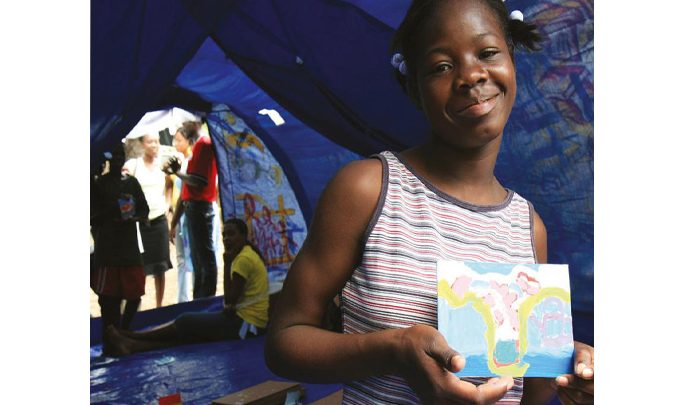Connect Children With Real-World Disasters Through Literacy Lessons

Is it appropriate to use real-world disasters – recent or otherwise – as stimuli for literacy activities? Kate Lea explains the thinking behind Oxfam’s Stories from Haiti…

- by Kate Lea

TR&W: Why did Oxfam decide to create a resource based on the Haitian earthquake?
KL: Sadly, we know that news of destructive earthquakes, hurricanes, floods and tsunamis will hit the world’s headlines every year. Most primary school learners will be aware of such events through watching or reading the news. Yet, because they are only reported for a short time before the world’s press moves on to other things, there are many unfinished stories about places where disasters have struck. The story of Haiti’s earthquake is no exception, and the untold narrative is not just one story of a disastrous earthquake. It is a multi-layered and complex combination of many histories, which demonstrate the resilience and determination of Haitian people in the face of difficulty. Stories from Haiti sets out to explore some of Haiti’s multiple stories and answer such questions as:
- What happened to the survivors of the earthquake after the world’s news reporters left Haiti?
- Why did the Haitian earthquake cause such unprecedented levels of destruction?
- Why do the poorer members of communities suffer most in any disaster?
Ultimately, Stories from Haiti builds on tragedy to develop a rounded and positive approach to understanding the wider world.
Is there a right or wrong way of bringing stories like the Haitian earthquake into the classroom?
Yes! Most teachers will be aware of the limitations of the media, whose job is, after all, to provide news as quickly as possible. This can lead to a distortion of the facts, either through misrepresentation or omission. For example, to present disasters such as the Haitian earthquake solely as a natural phenomenon is to omit the important point that it is poverty which usually causes so many people to die, be injured or become homeless. A further example of misrepresentation is the tendency to portray those caught up in disasters as victims, which does a great disservice to their resilience and determination. Stories from Haiti provides case studies which give teachers engaging stories and evidence to help them challenge such misinformed views.
How does getting learners to engage with a disaster like the Haitian earthquake support teaching and learning?
There is nothing like studying a real-life issue Haitian people from that created by the choice of words and phrases in an article written by a Haitian newspaper, La Nouvelliste.
Why has Stories from Haiti been linked to the new literacy curriculum, and how does it support its delivery?
There is a growing appreciation of how global learning can be used to great effect in core curriculum subjects like English to engage learners and boost achievement. We have therefore sought to provide more support for teachers of literacy by creating subject-specific resources alongside our more ‘traditional’ cross-curricular resources.
Written by English teachers, Stories from Haiti was produced in close collaboration with the National Association for the Teaching of English (NATE), and we are delighted that this inspiring subject association endorses the resources.
Taking the Haitian earthquake as a starting point, pupils use other real-life stories from Haiti to develop their spoken language, reading and writing. Stories from Haiti gets learners working with real newspaper reports and both fictional and factual stories written in response to the earthquake, using them to inform their own stories about Haiti. Each of the twelve flexible lessons has clear Learning Objectives, Outcomes, Key Questions and links to the new English curriculum.
In part one, which looks at stories from Haiti up to 2010, pupils can:
- Generate lists of adjectives to describe photographs of Haiti which challenge stereotypical images of the country
- Take part in guided reading activities to extract and share information about the earthquake
- Use card games, dominoes and a quiz to extend their vocabulary
- Use role play to explore historical factors which led to so many people being vulnerable when the earthquake struck
- Compare the language used by the international and the Haitian press to describe the events of the earthquake
In part two, which looks at stories from Haiti from 2011.2014, pupils can:
- Consider how media stories change over time
- Take on the role of a journalist to gather survivorsf stories and create a newspaper report which includes both direct and reported speech
- Take part in collaborative learning to introduce themselves to others in role as earthquake survivors
- Explore persuasive language and devices used in a leaflet about the benefits of urban gardening for earthquake survivors living in Port-au-Prince.
- Produce their own creative piece to share some of the stories they have learned about Haiti.
Teaching the tough stuff
Three points to remember when planning any work based on disasters.
1. Even the youngest of children can be exposed to disasters and suffering through the media and their own life experiences. The classroom can provide a much needed safe-space in which they can begin to understand these human experiences while also exploring wider perspectives and stories of hope and resilience (such as those highlighted in Oxfam’s Stories from Haiti but not always featured in media reporting).
2. Be prepared for some difficult questions and emotional responses, especially when it comes to producing creative writing, or role play; and have support strategies in place in case any children need some extra help processing the information.
3. Remember that there may be pupils in your class who have family links to recent disasters, which may require additional sensitivity. In any case, it is advisable to keep parents in the loop when handling any potentially sensitive issues or distressing material in the classroom.
Visit www.oxfam.org.uk/education to download Stories From Haiti for 7–11-year-olds, accompanying SEN resources, and Oxfam’s English and Global Citizenship Guide.








